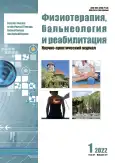Динамическая электронейростимуляция в когнитивной реабилитации пациентов в раннем восстановительном периоде ишемического инсульта
- Авторы: Дробышев В.А.1, Шпагина Л.А.1, Абрамович С.Г.2, Машанская А.В.2
-
Учреждения:
- Новосибирский государственный медицинский университет
- Иркутская государственная медицинская академия последипломного образования ― филиал «Российской медицинской академии непрерывного профессионального образования»
- Выпуск: Том 21, № 1 (2022)
- Страницы: 55-64
- Раздел: Оригинальные исследования
- URL: https://journal-vniispk.ru/1681-3456/article/view/108973
- DOI: https://doi.org/10.17816/rjpbr108973
- ID: 108973
Цитировать
Аннотация
Обоснование. Постинсультные когнитивные нарушения отрицательно влияют на результаты реабилитации, ухудшая исходы восстановления двигательных функций, повседневную активность и увеличивая вероятность повторного инсульта и преждевременной смерти. Лечебные физические факторы способствуют активации резервных возможностей организма и направлены на коррекцию метаболических и сосудистых нарушений, улучшение функционального состояния нервной системы, что позволяет применять их в комплексе реабилитационных мероприятий.
Цель исследования ― обосновать применение динамической электронейростимуляции в коррекции когнитивных нарушений у пациентов в раннем восстановительном периоде ишемического инсульта.
Материал и методы. Проведено проспективное когортное исследование 60 пациентов (средний возраст 62,4±4,5 года) в раннем восстановительном периоде ишемического инсульта с лёгкими и умеренными когнитивными нарушениями, разделённых методом случайной выборки на 3 группы. Пациенты 1-й группы (n=25) помимо базового комплекса, включающего медикаментозное лечение, занятия с нейропсихологом, массаж и лечебную физкультуру, получали 15-дневный курс динамической электронейростимуляции от аппарата «Нейродэнс-ПКМ» на протяжении 15 дней; во 2-й группе (n=20) ― базовый комплекс и процедуры «Нейродэнс-ПКМ» от плацебо-аппарата; в 3-й группе (n=15) ― только базовый комплекс. Всем пациентам проводилась оценка когнитивного статуса с использованием Монреальской шкалы психического статуса (МоСА) и батареи лобной дисфункции (FAB), а также исследование психофизиологического статуса на психофизиологическом тестере «НС-ПсихоТест» с использованием следующих инструментов: теппинг-тест, красно-чёрные таблицы Шульте–Платонова, простая зрительно-моторная реакция, реакция на движущийся объект.
Результаты. В динамике двухнедельной реабилитации установлено, что дополнение стандартной терапии когнитивных нарушений у пациентов в раннем восстановительном периоде ишемического инсульта динамической электростимуляцией способствует улучшению внимания, памяти, беглости речи, функции обобщения, выполнению усложнённой реакции выбора, в том числе повышает функции зрительного внимания и скорость сенсомоторных реакций, чего не отмечалось в группах сравнения.
Заключение. Включение динамической электронейростимуляции в комплексную реабилитацию пациентов в раннем восстановительном периоде ишемического инсульта с когнитивными нарушениями лёгкой и умеренной степени может влиять на когнитивные функции за счёт стимуляции третьего блока мозга по А.Р. Лурия и улучшения нейродинамического обеспечения высшей психической деятельности.
Полный текст
Открыть статью на сайте журналаОб авторах
Виктор Анатольевич Дробышев
Новосибирский государственный медицинский университет
Автор, ответственный за переписку.
Email: Doctorvik@yandex.ru
ORCID iD: 0000-0002-7093-3071
SPIN-код: 6953-8702
д.м.н., профессор
Россия, НовосибирскЛюбовь Анатольевна Шпагина
Новосибирский государственный медицинский университет
Email: lashpagina@gmail.com
ORCID iD: 0000-0003-0871-7551
SPIN-код: 5773-6649
д.м.н., профессор
Россия, НовосибирскСтанислав Григорьевич Абрамович
Иркутская государственная медицинская академия последипломного образования ― филиал «Российской медицинской академии непрерывного профессионального образования»
Email: prof.abramovich@yandex.ru
ORCID iD: 0000-0002-4280-9217
SPIN-код: 2407-4146
д.м.н., профессор
Россия, ИркутскАлександра Валерьевна Машанская
Иркутская государственная медицинская академия последипломного образования ― филиал «Российской медицинской академии непрерывного профессионального образования»
Email: ale-Mashanskaya@yandex.ru
ORCID iD: 0000-0003-1792-6822
SPIN-код: 7189-3905
к.м.н.
Россия, ИркутскСписок литературы
- Virani S.S., Alonso A., Aparicio H.J., et al. Heart disease and stroke statistics - 2021 update: a report from the American heart association // Circulation. 2021. Vol. 14, N 8. Р. 254–743.doi: 10.1161/CIR.0000000000000950
- Thrift A.G., Howard G., Cadilhac D.A., et al. Global stroke statistics: an update of mortality data from countries using a broad code of "cerebrovascular diseases" // Int J Stroke. 2017. Vol. 12, N 8. Р. 796–801. doi: 10.1177/1747493017730782
- Старчина Ю.А. Когнитивные нарушения после инсульта // Медицинский Совет. 2017. № 1S. С. 27–32.doi: 10.21518/2079-701X-2017-0-27-32
- Norrving B., Barrick J., Davalos A.M., et al. Action plan for stroke in Europe 2018–2030 // Eur Stroke J. 2018. Vol. 3, N 4. Р. 309–336. doi: 10.1177/2396987318808719
- Прокопенко С.В., Анайоол Т.С., Безденежных А.Ф. Оценка когнитивных нарушений у двуязычных пациентов, перенесших ишемический инсульт // Неврологический журнал. 2017. Т. 22, № 2. С. 78–85.doi: 10.18821/1560-9545-2017-22-2-78-85
- Билалова Р.Р., Ибрагимова Г.З., Зайцева А.Р., и др. Опыт лечения сочетанной патологии острого нарушения мозгового кровообращения и инфаркта миокарда // Вестник современной клинической медицины. 2018. Т. 11, № 5. С. 16–22.doi: 10.20969/vskm.2018.11(5).16-22
- Кадыков А.С., Черникова Л.А., Шахпаронова Н.В. Реабилитация неврологических больных. Реабилитация неврологических больных. 4-е изд. Москва: МЕДпресс-информ, 2021. 560 с.
- Goldstein L.B., Bushnell C.D., Adams R.J., et al. Guidelines for the primary prevention of stroke: a guideline for healthcare professionals from the american heart association // Am Stroke Association. 2011. Vol. 42, N 2. Р. 517–584.doi: 10.1161/str.0b013e3181fcb238
- Cumming T.B., Tyedin K., Churilov L. The effect of physical activity on cognitive function after stroke: a systematic review // Int Psychogeriatrics. 2012. Vol. 24, N 4. Р. 557–567.doi: 10.1161/STROKEAHA.117.017319
- Кадыков А.С., Шахпаронова Н.В., Белопасова А.В., Пряников И.В. Нейропластичность и восстановление нарушенных функций после инсульта // Физическая и реабилитационная медицина, медицинская реабилитация. 2019. Т. 1, № 2. С. 32–36. doi: 10.36425/2658-6843-19184
- Прокопенко С.В., Можейко Е.Ю., Корягина Т.Д. Возможности когнитивного тренинга с использованием специализированных компьютерных программ у больных, перенесших инсульт // Неврологический журнал. 2014. Т. 19, № 1. С. 20–24.
- Кадочникова Е.Ю., Власов А.А., Алексеева Л.И., и др. Эффективность динамической электронейростимуляции (ДЭНС) в лечении остеоартроза коленных суставов (результаты многоцентрового рандомизированного исследования) // Остеопороз и остеопатии. 2016. Т. 19, № 2. С. 107–107.doi: 10.14341/osteo20162107-107
- Омочев О.Г., Чичилов М.А. Особенности комплексного воздействия электронейромиостимуляции и акупунктуры при пояснично-крестцовой дорсопатии // Физиотерапия, бальнеология и реабилитация. 2018. Т. 17, № 1. С. 29–31.doi: 10.18821/1681-3456-2018-17-1-29-31
Дополнительные файлы










